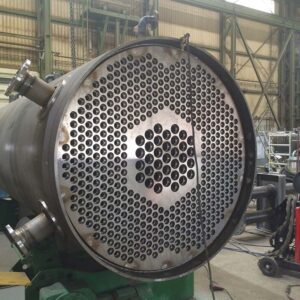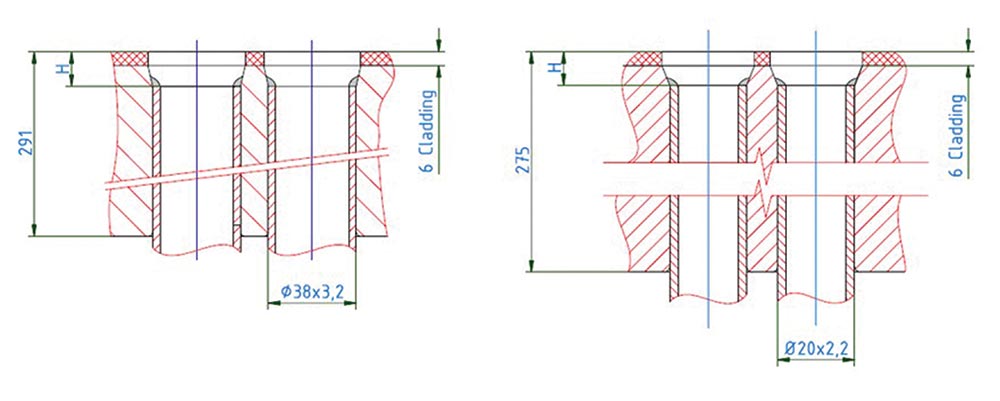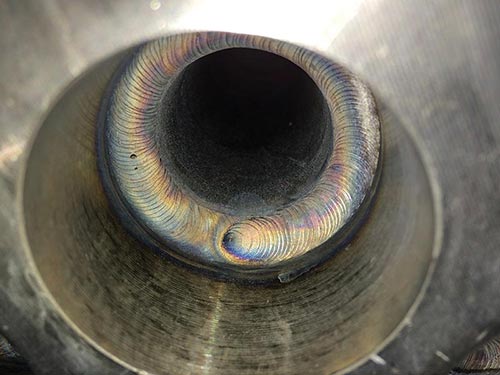ACE Apparatebau Construction & Engineering GmbH provides an insight in to the different types of waste-heat boiler designs and their tube-to-tubesheet connection details in steam reforming plants.
Introduction
Steam reforming of light carbohydrates, i.e. the produc-tion of hydrogen from natural gas, is an endothermic process. This means that heat needs to be supplied to produce hydrogen. The final product gas has a temperature of approximately 1000°C and needs to be cooled to 350°C for the CO-conversion to reduce the amount of undesired carbon monoxide in the shift reaction process [1]. Cooling takes place in the waste-heat boilers, right after the secondary process step by heating and evaporating water resulting in high-pressure steam.
Types of waste-heat boilers in steam reforming plants

Given these harsher process conditions, i.e. high temperature, high pressure, and high gradients of both, construction and manufacturing are more challenging. Therein, a larger factor lies on the tube-to-tubesheet welding, i.e. the connection of each single tube-to-tubesheet. Conceptionally, two types can be distin-guished by their operation mode: water-tube boilers, and fire-tube boilers. In water-tube boilers, the hot gas is on the shell side, which is outside the tubes and the cooling water is inside the tubes of the heat exchanger/boiler. It is vice-versa for the fire-tube boiler [1]. The main difference in manufacturing and operation: The fire-tube boiler is more complex to manufacture because of higher stresses in the tube-to-tubesheet connection, but has advantages in the operation as the water evaporation can be more adaptive to the load when on the shell side. Still, both types are demanding regarding the construction and manufacturing process.
A main criterion for safe operation – Material selection for tube-to-tubesheet connections
To withstand harsh process conditions it is important to select the proper material, especially the tube, tubesheet, and the welding filler material. The tube and tubesheet material thereby is chosen according to the gas and process demand and guided by regulations, for example, the American Petroleum Institute standards API-941. In so-called hydrogen service, such materials, especially the tubes and the plates, are susceptible to hydrogen embrittlement and bubble formation, which can lead to stress crack formation or even surface decarburization at high temperatures. Due to their high temperature properties, low-alloyed Cr-Mo carbon steels are suitable for use in waste-heat boilers.
Generally, in addition to the standardized material testing (hot tensile test and charpy impact test), a simulation heat treatment is carried out and a new metallurgical test is conducted.
The second criterion is the suitable welding fi ller material: the Cr- and Mo content of the filler material must meet the specifications of the base material.
Process development of automated tube-to-tubesheet welding connections for waste-heat recovery boilers in ammonia plants.
The prime goal in the process development and welding process is a 100% reproducibility, at the lowest error rate (zero error strategy). The tube-to-tubesheet welding is carried out with a fully automatic tungsten inert gas welding process (TIG orbital welding). In addition, hazards, such as hydrogen embrittlement or stress corrosion (SCC), for example, are minimized by defining optimal tube welding details, as determined by means of FEM analysis of the tube-to-tubesheet connections. The first step is to determine the boundary conditions, such as the operating data, materials used and welding seam geometry. The next step is to check the weldability and feasibility of the geometry using an automated TIG orbital welding head. A 100% guarantee of the welding head position for the welding of every tube is the most important step to ensure controlled, fully automated tube-to-tubesheet welding. Thus, the constructive design of a clamping and centering system for the orbital welding head is crucial. Once the welding geometry has been determined and the orbital clamps have been precisely positioned, test specimens for trial welds are prepared. For the tests, at least three to four test series with at least ten tube-to-tubesheet welds each are carried out. The metallurgical and metallographic evaluations of the test welds are used to determine the exact values for the feed speed of the filler metal, the current strength and the geometric adjustment of the orbital welding head. This empirical determination of the welding parameters is decisive for the development of reliable tube-to-tubesheet welding for use in waste-heat boilers in ammonia plants. From a manufacturing point of view, care must be taken to avoid the formation of stress cracks. The majority of defects in tube welding stems from the mechanism of hydrogen-assisted SCC.
In order to reduce the risk of cracking, a metallographic examination and a chemical analysis of each of the work samples must be carried out on in order to rule out any welding defects in advance.
Practical experience on the part of ACE – Examples of the production of operationally reliable tube-to-tubesheet connections:
The highest priority when manufacturing a waste-heat boiler is the production of a safe tube-to-tubesheet connection. Besides optimizing the seam geometry for fully automated tube-to-tubesheet welding, additional requirements, such as repair options in the event of damage, a new design due to increased system performance, or the incorporation of specific customer requirements, also play a significant role. Experience has shown that the most important step in this process is the successful evaluation of the test welds produced in order to actually use the tube-to-tubesheet welding on the apparatus. The following examples reflect the proven designs of waste-heat boilers, namely the water-tube boiler and the fire-tube boiler.
(a) Tube-to-tubesheet connections in a water-tube boiler
The tube-to-tubesheet welding details in Fig. 2 show two typical execution examples for a tube-to-tubesheet connection of a water-tube boiler, used in waste-heat boilers after the secondary reformer. These were newly designed due to an increase in performance and problems with existing boilers.
As previously described, low alloyed Cr-Mo carbon steels are used for the waste-heat boiler. In particular, the tubesheet is made of 11/4Cr-1/2Mo steel and the tubes are made of 21/4Cr-1Mo steel. Due to their weldability, this material combination is to be treated similarly and automated welding works well. With this material combination, it is important to note that these two types of steel are air hardened. This causes hardening, during cooling, from the welding heat in the heat-influenced zone and represents a cracking risk in connection with the residual welding stresses. Therefore, optimum heat conduction during welding is to be ensured and post-weld heat treatment (PWHT) is required. The tubes are welded in two passes and the challenge for this tube-to-tubesheet welding detail is to create accessibility for the TIG-welding head; especially in the case of ø20 mm tube diameter, this project proves to be difficult. In order to guarantee an optimal root run for the tube-to-tubesheet welding, a conical attachment is used for drilling the tubesheet. The choice of the conical extension height at the tubesheet is decisive for the optimum accessibility of the welding head and the basic prerequisite for standard-compliant seam geometry. The optimal height of the attachment is ascertained via test welds and determined by design. After successful completion of the tube welds and the non-destructive tests (NDE), each tube must also be hydraulically expanded (3-5% expansion of the inner tube diameter), which provides improved protection against corrosion of the weld seam from hot cracked gas flowing through the shell side.
In addition, a weld cladding is carried out on the top of the tubesheet (Fig. 2). This offers the advantage that no additional PWHT has to be made for welding repairs on the tubesheet. This application is important for the service life of the waste-heat boiler, especially after damage to a tube or leakage in a tube. For weld-in details, such as Fig. 2, austenitic weld cladding is to be carried out on the upper side of the tubesheet. In the event of a repair, the tube bore can then be simply welded with a plug of the same material and no PWHT has to be carried out after welding.

(b) Tube-to-tubesheet connections of a fire-tube boiler
The example in Fig. 3 shows a tube-to-tubesheet con-nection weld detail, as used in a fire-tube boiler. Low-alloyed Cr-Mo carbon steels are the preferred materials for this tube-to-tubesheet connection. In contrast to the above-mentioned designs, the tube weld is additionally protected by a ceramic heat shield and ferrule due to the hot cracked gas on the pipe side of the secondary reformer. The tube-to-tubesheet welds are carried out on the back of the tubesheet. Due to this gap-free connection between tube and tubesheet, the possibility of crevice corrosion in water tube boilers can be prevented.


In terms of manufacturing, this variant requires a great deal of mechanical processing for weld seam preparation compared to conventional tube-to-tubesheet connections. In order to be able to guarantee a 100% reproducible welding seam, the tubes must be processed to a gap dimension in the tenth of a millimeter range. In addition, the centered positioning of the TIG welding orbital head during welding is crucial and specific positioning devices are to be developed specifically for each tube-to-tubesheet detail and tested on the basis of trial welds, see Fig. 4. Due to the high cost of so-called in bore welds, at least twice the amount of work required for conventional tube-to-tubesheet connections, compared to conventional tube welds, is to be expected.
Conclusion
For waste-heat boilers in steam reforming plants the most challenging task is to meet the requirements of tube-to-tubesheet connection because of the harsher process conditions. Each tube-to-tubesheet weld is unique, in which the choice of the material, especially the tube material, tubesheet and the welding filler material on the one hand as well as the details on the welding process on the other hand have an important impact on the weldability.
The prime goal in the process development for tube-totubesheet welding thereafter is a 100% reproducibility, at the lowest error rate (zero error strategy).
Reference
[1] Appl, Max: Ammonia: Principles and industrial practice, Wiley-VCH, I999 p. 172–177.
About this Featured Story
This Featured Story was first published in the May 2021 issue of Heat Exchanger World Magazine. To read more Featured Stories and many other articles, subscribe to our print magazine.
Featured Stories are regularly shared with our Heat Exchanger World community. Join us and share your own Featured Story on Heat Exchanger World online and in print.


